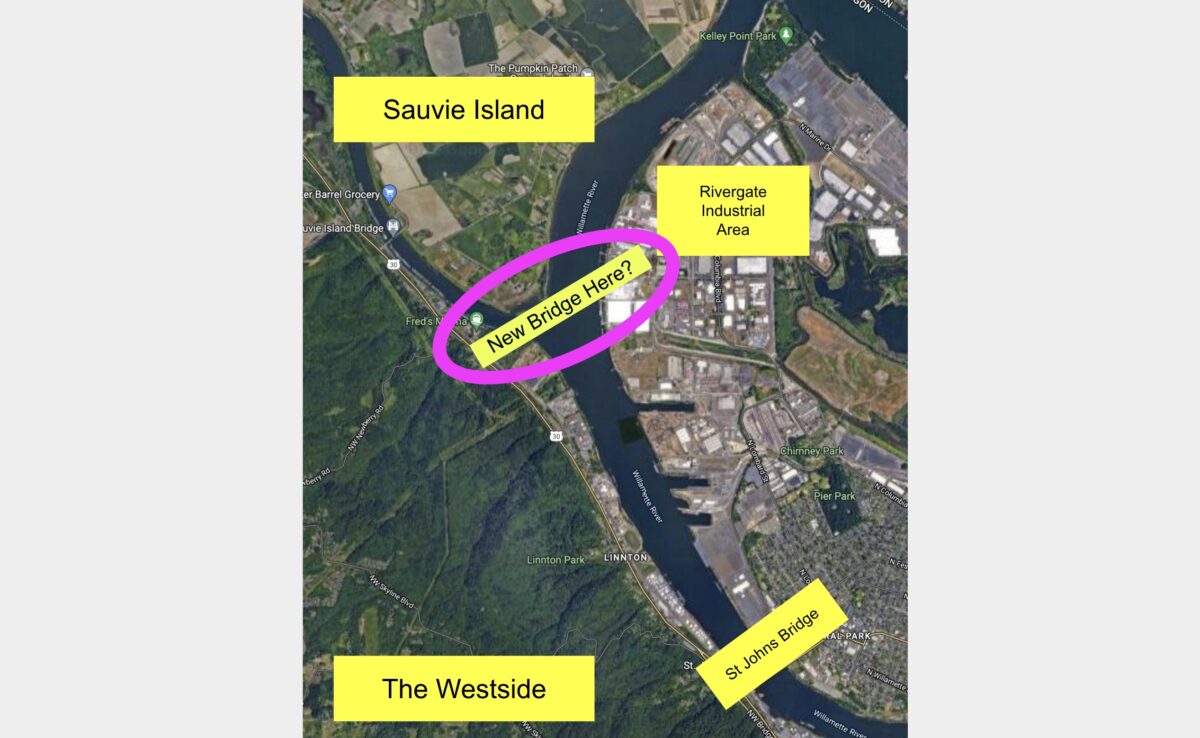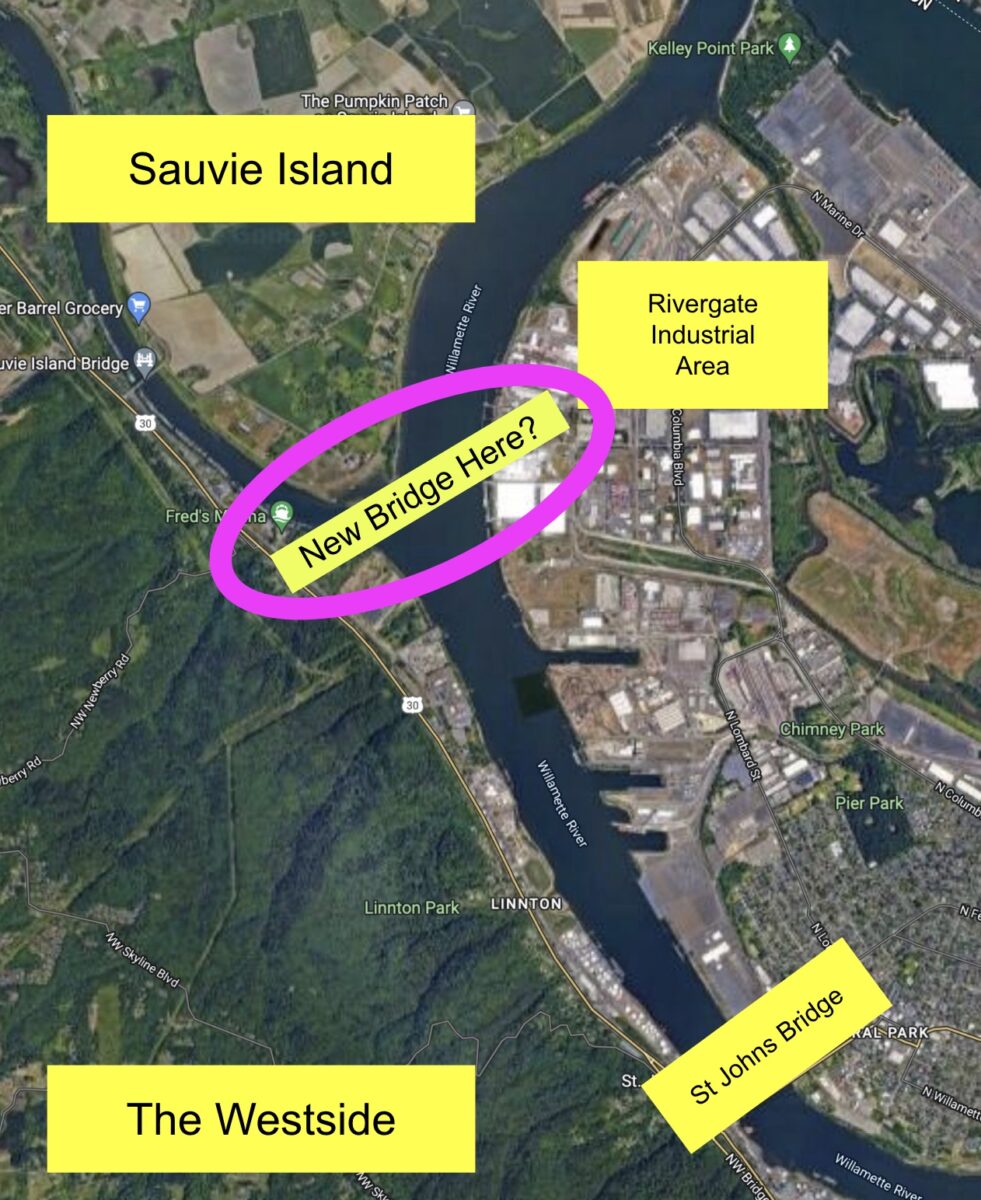“Any such bridge would also include separated pedestrian and bicycle facilities.”
– Hannah Schafer, PBOT
Initial talks have begun on what could be a very exciting project: A new crossing of the Willamette River north of the St. Johns Bridge between Highway 30 and the Rivergate Industrial District.
At a recent meeting of the Portland’s Freight Advisory Committee, we heard an update about the 2040 Freight Plan. This is a major effort from the Portland Bureau of Transportation to update the city’s Freight Master Plan that was last updated in 2006. On a slide with a list of projects that would be late additions to an action list, I saw an item that read: “Conduct a study of a freight-only or freight-priority bridge over the Willamette River from Highway 30 to Rivergate.”
Why would this bridge be a such a big deal? Let me count the ways…
First, the state’s main justification for not putting bike lanes on the St. Johns Bridge is that they need all the space for large freight trucks. A new bridge would remove that excuse from their quiver. But even larger than that, in terms of impacts to Portlanders lives, is if we had a way to get trucks off the St. Johns Bridge it would remove thousands of toxic, dangerous vehicles from neighborhoods along the Lombard and Columbia corridors. People have fought for decades to tame truck traffic in St. Johns. Removing it from those streets would also free up space for more things like buses, bike lanes, or even light rail.
Then there’s the lesser important, but selfish dream I’ve held for years: A better cycling connection between Kelley Point Park and Sauvie Island that would remove (most of) Highway 30 from the route. This would push an already nice route into world-class territory.
Eager to know more about this, I asked our friends at PBOT to share more about it.
Turns out this idea has been bouncing around since at least 2007 when it was mentioned in PBOT’s Transportation System Plan (TSP) as a “future study.” For some reason however, the study didn’t make it into the recent TSP update in 2018. Despite that, PBOT Interim Communications Director Hannah Schafer assured me that, “There is still strong community desire,” for the project. She pointed to public feedback heard during PBOT’s Columbia Lombard Mobility Corridor and North Portland in Motion planning processes. Even freight advocates have expressed concerns about the current trucking routes over the St. Johns Bridge during 2040 Freight Plan discussions.
Another place this project is being discussed is in the Westside Multimodal Improvements Study, a process we covered back in June. Led by Metro and Oregon Department of Transportation, this study is establishing priorities for investment along the Highway 26 corridor in Washington County. One of their specific goals is to speed up trucks carrying freight from Beaverton and Hillsboro to the Portland Airport. (Given the folks around the table, it’s likely this could be the place where talks of a new “Westside Bypass” freeway takes root once again, but I digress.)
“Based on all this, we think it is appropriate to recommend [the new bridge idea] be included in 2040 Freight and the TSP as a future study,” Schafer shared in an email today.
Schafer also wanted me to know that Portland would not support a bridge that serves standard car traffic and that the idea would be for a new bridge to focus solely on moving goods. That’s why they plan to frame any talk of a new bridge around “freight-only” or “freight-priority.” This could mean the bridge would require special permits for use, or it could have tolls for non-truck users, truck-only lanes, and so on. Those things would need to be studied in more detail.
One very pleasing thing Schafer wrote about a potential bridge was that, “Any such bridge would also include separated pedestrian and bicycle facilities, so it would not be truly ‘freight-only’ when you consider uses outside the curb-to-curb area.”
Imagine a situation where bicycle riders and freight haulers are considered default users of a major new bridge and car users have to organize and advocate to justify access for their vehicles!
Suffice it to say I’m eager for this idea to gain a toehold in local funding and planning conversations.





